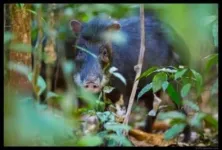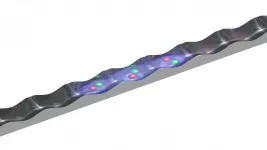(Press-News.org) The White-lipped peccary Tayassu pecari is a boar-like hoofed mammal found throughout Central and South America. These animals roam the forest in bands of 50 to 100 individuals, eating a wide variety of foods. In Brazil's Atlantic Rainforest, they prefer the fruit of the jussara palm Euterpe edulis.
The jussara is very abundant in this biome, probably thanks to vast amounts of dung, urine, and soil trampling by peccaries as well as tapirs (Tapirus terrestris) and other fruit-eating animals, or frugivores. This behavior releases forms of nitrogen, a key element in plant growth.
A study supported by São Paulo Research Foundation - FAPESP and published in the journal Functional Ecology showed that in areas free of these frugivores the level of ammonium, a form of nitrogen in soil, was up to 95% lower. The findings evidence for the first time the importance of these animals to the nitrogen cycle and serve as yet another warning of the ecosystem losses caused when large mammals disappear from tropical forests.
"Any farmer knows how crucial the nitrogen cycle is to achieve high crop yields. Studies in other environments have already shown that the presence of ruminants stimulates the growth of grasses thanks to the effect of their excretions on the nitrogen cycle, including optimization of microorganism activity. Our latest study has now shown that large fruit-eating mammals provide the same service in tropical forests," said Nacho Villar, first author of the article. Villar is a researcher affiliated with São Paulo State University's Institute of Biosciences (IB-UNESP) in Rio Claro, Brazil. Currently he is a postdoctoral fellow at the Netherlands Institute of Ecology (NIOO-KNAW).
The study also shows that these animals redistribute nitrogen, fertilizing areas that would otherwise be nutrient-poor, and hence sustain plant growth. According to the researchers' estimates, such areas receive four times more ammonium and 50 times more nitrate than areas without frugivores.
The study was part of the Thematic Project "Ecological consequences of defaunation in the Atlantic Rainforest", for which the principal investigator was Mauro Galetti, a professor at IB-UNESP, and was conducted under the auspices of FAPESP's Research Program on Biodiversity Characterization, Conservation, Restoration and Sustainable Use (BIOTA-FAPESP)).
The researchers used South America's leading herbivore exclosure experiment, comprising 86 forest plots measuring 15 square meters in Serra do Mar State Park (São Paulo State), Brazil's largest continuous Atlantic Rainforest reserve. Half the plots have been fenced since 2010 to prevent the entry of large mammals. All animals can roam freely into and out of the other plots.
Camera traps on fenced and open plots demonstrated the presence or absence of White-lipped peccaries, Collared peccaries (Pecari tajacu) and tapirs, among other frugivores.
Microorganisms, ammonium and nitrate
In this study, the researchers analyzed soil samples from eight exclusion plots and their paired open controls, collected in the wet and dry seasons. Jussara palm abundance varied across the different plots.
In soil from open plots, ammonium levels were 95% higher, and rates of nitrification (conversion of ammonium to nitrate) were also higher owing to the frugivore-driven abundance of microorganisms in the soil. Although plants absorb ammonium, their metabolism can immediately use nitrate, which is therefore considered more valuable in terms of plant growth.
"Peccaries account for 80% to 90% of the total mammal biomass in the Atlantic Rainforest. Large groups of these animals roam extensive territories, fertilizing the forest," Villar said. "Tapir density is lower, so their contribution to the nitrogen cycle isn't as great, but the amount excreted by each individual is considerable, as is each animal's range as it disperses seeds." Another study by the same group had already shown how peccaries and tapirs contribute to plant species diversity and abundance (read more at: https://agencia.fapesp.br/31840).
This large frugivore biomass is attracted by the vast amount of fruit from jussara palms, whose abundance is due to fertilization of the soil by the animals' excretions (which also probably increase the palms' fruit-bearing capacity). The outcome is a virtuous cycle for animals, plants and soil microorganisms (also stimulated by the excretions), leading the researchers to propose the term "fruiting lawns" as a description of such areas. The term is considered analogous to the concept of grazing lawns, which refers to the positive feedback between ruminant food consumption and food availability in African savannas and other grassland landscapes.
The next steps in the group's research will include investigating whether the increase in nitrogen due to plants' interaction with large mammals boosts their carbon absorption and reduces the release of greenhouse gases from the soil. If so, plant-animal interaction should play a major role in regulating global climate change.
INFORMATION:
About São Paulo Research Foundation (FAPESP)
The São Paulo Research Foundation (FAPESP) is a public institution with the mission of supporting scientific research in all fields of knowledge by awarding scholarships, fellowships and grants to investigators linked with higher education and research institutions in the State of São Paulo, Brazil. FAPESP is aware that the very best research can only be done by working with the best researchers internationally. Therefore, it has established partnerships with funding agencies, higher education, private companies, and research organizations in other countries known for the quality of their research and has been encouraging scientists funded by its grants to further develop their international collaboration. You can learn more about FAPESP at http://www.fapesp.br/en and visit FAPESP news agency at http://www.agencia.fapesp.br/en to keep updated with the latest scientific breakthroughs FAPESP helps achieve through its many programs, awards and research centers. You may also subscribe to FAPESP news agency at http://agencia.fapesp.br/subscribe.
Boston - A national group of pediatric addiction medicine experts have released newly-established principles of care for young adults with substance use disorder. Led by the Grayken Center for Addiction at Boston Medical Center, the collection of peer-reviewed papers was developed to guide providers on how to treat young adults with substance use disorder given their age-specific needs, as well as elevate national discussions on addressing these challenges more systematically.
Published in Pediatrics, the 11-paper supplement is the result of a convening of national experts in the treatment of young adults to determine the most important principles to address when caring for this unique population of patients with substance use disorder. ...
Liquids are ubiquitous in Nature: from the water that we consume daily to superfluid helium which is a quantum liquid appearing at temperatures as low as only a few degrees above the absolute zero. A common feature of these vastly different liquids is being self-bound in free space in the form of droplets. Understanding from a microscopic perspective how a liquid is formed by adding particles one by one is a significant challenge.
Recently, a new type of quantum droplets has been experimentally observed in ultracold atomic systems. These ones ...
Researchers from Skoltech and the University of Texas Medical Branch (US) have shown how optoacoustics can be used for monitoring skin water content, a technique which is promising for medical applications such as tissue trauma management and in cosmetology. The paper outlining these results was published in the Journal of Biophotonics.
(swelling caused by fluid accumulation) or dehydration, which can also have cosmetic impacts. Right now, electrical, mechanical and spectroscopic methods can be used to monitor water content in tissues, but there is no accurate and noninvasive technique that would also provide a high resolution and significant probing depth required for potential clinical applications.
Sergei Perkov of the Skoltech Center for Photonics ...
COLUMBUS, Ohio - "Buy low and sell high" says the old adage about investing in the stock market.
But a relatively new type of investment fund is luring unsophisticated investors into buying when values are at their highest, resulting in losses almost immediately, a new study has found.
The lure? Buying into trendy investment areas like cannabis, cybersecurity and work-from-home businesses.
"As soon as people buy them, these securities underperform as the hype around them vanishes," said Itzhak Ben-David, co-author of the study and professor of finance at The Ohio State University's Fisher College of Business.
"They appeal to people who are not sophisticated ...
New Rochelle, NY, January 15, 2021--The biodistribution of adeno-associated virus (AAV) gene transfer vectors can be measured in nonhuman primates using a new method. The method quantifies whole-body and organ-specific AAV capsids from 1 to 72 hours after administration. Study design and results are presented in the peer-reviewed journal Human Gene Therapy. Click here to read the full-text article free on the Human Gene Therapy website through February 15, 2021.
AAV capsids were labeled with I-124 and delivered using two routes of administration: intravenous and directly into the cerebrospinal fluid (CSF). Biodistribution was measured by quantitative positron emission tomography (PET) at 1, 24, 48, and 72 hours after AAV administration. Two AAV vectors - AAVrsh.10 and AAV9 - were compared.
"Following ...
HAMILTON, ON, Jan. 15, 2021 -- A team of neuroscientists and engineers at McMaster University has created a nasal spray to deliver antipsychotic medication directly to the brain instead of having it pass through the body.
The leap in efficiency means patients with schizophrenia, bipolar disorder and other conditions could see their doses of powerful antipsychotic medications cut by as much as three quarters, which is expected to spare them from sometimes-debilitating side effects while also significantly reducing the frequency of required treatment.
The new method delivers medication in a spray that reaches the brain directly through ...
Pediatric laryngotracheal stenosis (LTS), a narrowing of the airway in children, is a complex medical condition. While it can be something a child is born with or caused by injury, the condition can result in a life-threatening emergency if untreated.
Treatment, however, is challenging. Depending on the severity, doctors will use a combination of endoscopic techniques, surgical repair, tracheostomy, or deployment of stents to hold the airway open and enable breathing.
While stents are great at holding the airway open and simultaneously allowing the trachea to continue growing, they can move around, ...
There is currently no cure for osteoarthritis, but a group of scientists believe they've discovered a method through which a simple knee injection could potentially stop the disease's effects. These researchers showed that they could target a specific protein pathway in mice, put it into overdrive and halt cartilage degeneration over time. Building on that finding, they were able to show that treating mice with surgery-inducedknee cartilage degeneration through the same pathway via the state of the art of nanomedicine could dramatically reduce the cartilage degeneration and knee pain. These findings were published in Science Translational Medicine.
"Our lab is one of the few in the world studying epidermal growth factor receptor (EGFR) ...
The Gulf of Mexico holds huge untapped offshore oil deposits that could help power the U.S. for decades.
The energy super basin's longevity, whose giant offshore fields have reliably supplied consumers with oil and gas since the 1960s, is the result of a remarkable geologic past - a story that began 200 million years ago among the fragments of Pangea, when a narrow, shallow seaway grew into an ocean basin, while around it mountains rose then eroded away.
The processes that shaped the basin also deposited and preserved vast reserves of oil and gas, of which only a fraction has been extracted. Much of the remaining oil lies buried beneath ancient salt layers, just recently illuminated ...
MADISON, Wis. -- The demand for COVID-19 vaccines continues to outpace supply, forcing public health officials to decide who should be first in line for a shot, even among those in the same pool of eligible vaccine recipients.
To assist these efforts, researchers at the University of Wisconsin School of Medicine and Public Health and UW Health have developed a tool that incorporates a person's age and socioeconomic status to prioritize vaccine distribution among people who otherwise share similar risks due to their jobs. The tool helps identify those who are at greater risk of severe ...






